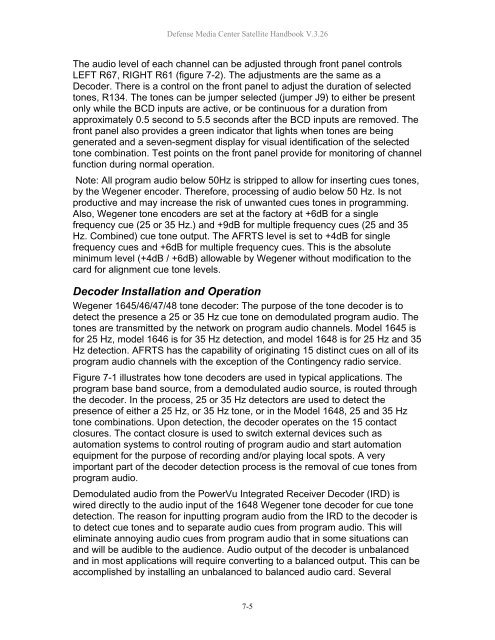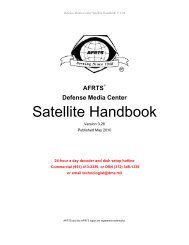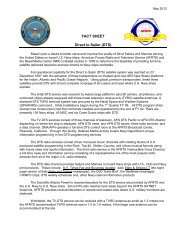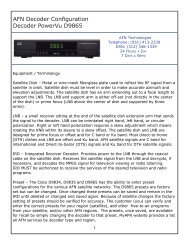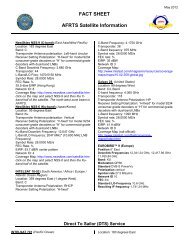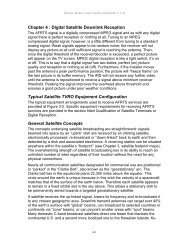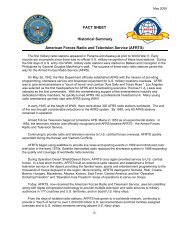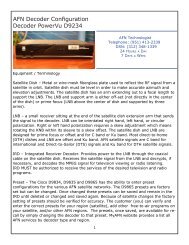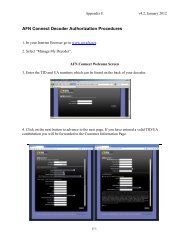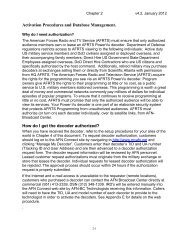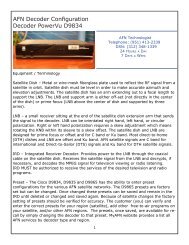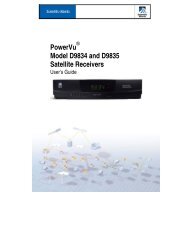AFRTS Defense Media Center Satellite Handbook
AFRTS Defense Media Center Satellite Handbook
AFRTS Defense Media Center Satellite Handbook
You also want an ePaper? Increase the reach of your titles
YUMPU automatically turns print PDFs into web optimized ePapers that Google loves.
<strong>Defense</strong> <strong>Media</strong> <strong>Center</strong> <strong>Satellite</strong> <strong>Handbook</strong> V.3.26<br />
The audio level of each channel can be adjusted through front panel controls<br />
LEFT R67, RIGHT R61 (figure 7-2). The adjustments are the same as a<br />
Decoder. There is a control on the front panel to adjust the duration of selected<br />
tones, R134. The tones can be jumper selected (jumper J9) to either be present<br />
only while the BCD inputs are active, or be continuous for a duration from<br />
approximately 0.5 second to 5.5 seconds after the BCD inputs are removed. The<br />
front panel also provides a green indicator that lights when tones are being<br />
generated and a seven-segment display for visual identification of the selected<br />
tone combination. Test points on the front panel provide for monitoring of channel<br />
function during normal operation.<br />
Note: All program audio below 50Hz is stripped to allow for inserting cues tones,<br />
by the Wegener encoder. Therefore, processing of audio below 50 Hz. Is not<br />
productive and may increase the risk of unwanted cues tones in programming.<br />
Also, Wegener tone encoders are set at the factory at +6dB for a single<br />
frequency cue (25 or 35 Hz.) and +9dB for multiple frequency cues (25 and 35<br />
Hz. Combined) cue tone output. The <strong>AFRTS</strong> level is set to +4dB for single<br />
frequency cues and +6dB for multiple frequency cues. This is the absolute<br />
minimum level (+4dB / +6dB) allowable by Wegener without modification to the<br />
card for alignment cue tone levels.<br />
Decoder Installation and Operation<br />
Wegener 1645/46/47/48 tone decoder: The purpose of the tone decoder is to<br />
detect the presence a 25 or 35 Hz cue tone on demodulated program audio. The<br />
tones are transmitted by the network on program audio channels. Model 1645 is<br />
for 25 Hz, model 1646 is for 35 Hz detection, and model 1648 is for 25 Hz and 35<br />
Hz detection. <strong>AFRTS</strong> has the capability of originating 15 distinct cues on all of its<br />
program audio channels with the exception of the Contingency radio service.<br />
Figure 7-1 illustrates how tone decoders are used in typical applications. The<br />
program base band source, from a demodulated audio source, is routed through<br />
the decoder. In the process, 25 or 35 Hz detectors are used to detect the<br />
presence of either a 25 Hz, or 35 Hz tone, or in the Model 1648, 25 and 35 Hz<br />
tone combinations. Upon detection, the decoder operates on the 15 contact<br />
closures. The contact closure is used to switch external devices such as<br />
automation systems to control routing of program audio and start automation<br />
equipment for the purpose of recording and/or playing local spots. A very<br />
important part of the decoder detection process is the removal of cue tones from<br />
program audio.<br />
Demodulated audio from the PowerVu Integrated Receiver Decoder (IRD) is<br />
wired directly to the audio input of the 1648 Wegener tone decoder for cue tone<br />
detection. The reason for inputting program audio from the IRD to the decoder is<br />
to detect cue tones and to separate audio cues from program audio. This will<br />
eliminate annoying audio cues from program audio that in some situations can<br />
and will be audible to the audience. Audio output of the decoder is unbalanced<br />
and in most applications will require converting to a balanced output. This can be<br />
accomplished by installing an unbalanced to balanced audio card. Several<br />
7-5


